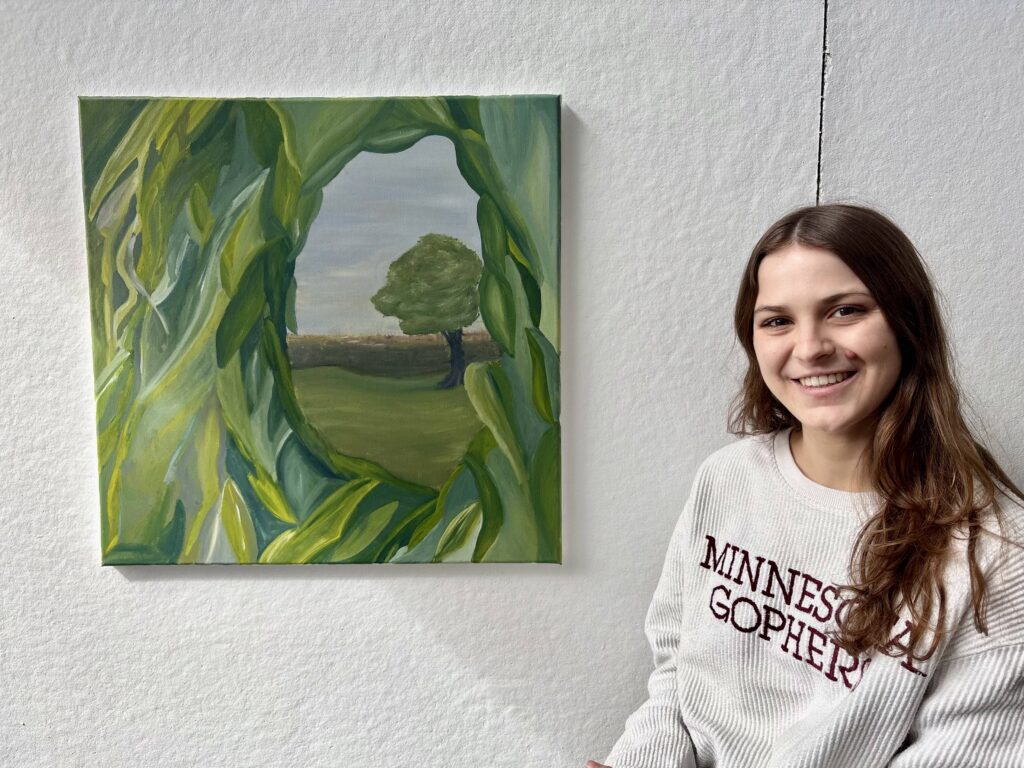By: Sophia Arndt
At the beginning of her final semester at the University of Minnesota, Malia Bronson found herself stumped by an assignment in her intermediate painting class. Her search for a solution led her straight into a controversy roiling the art community about the very nature of art.
Bronson, a fourth-year student studying architecture, and her classmates were asked by their professor to make abstract self-portraits. The trouble is, Bronson doesn’t do abstract. A devout Christian from rural Iowa, she calls herself an open book.
“It was hard for me to imagine abstracting something like that, and being myself,” Bronson said. “I was lost on where to start with that.”
Bronson’s long search for inspiration started in the countryside where she grew up and landed in the world of artificial intelligence.
“I remember going to my grandma’s house back home when I was younger, and she had this painting of this woman in a lavender field in her bathroom,” Bronson said. “This woman’s face was just placed in it, but it looked so natural. I’ve never seen other images like that.”
Bronson could not find the original artist nor the elusive painting from her childhood to reference while working. She was back at square one when she started to search Google for another jolt of inspiration.
“I clicked on this link, it was an AI website,” Bronson said.
The website specializes in generating images of portraits of nature with prompting from its users. Bronson entered a photo into the website with her specific idea of a face built into a landscape, picked from the choices of generated images, and got to work on her painting.
Initially, Bronson planned to represent her faith by painting her interpretation of the Holy Spirit as a dove nesting in an overgrown heart. However, after talking with her professor, Bronson decided to pursue a version of the portrait generated by the AI website.
“It was personal, but it wasn’t representative of me. It was representative of anybody who believes in that sort of thing,” Bronson said.
Her professor supported the idea of using the reference image produced by the website but cautioned Bronson against falling into the rabbit hole of generative AI art.
“She’s really pushing me, like ‘Don’t straight up copy this, don’t plagiarize. That’s not your original idea,’” Bronson said. “What I’m doing is kind of blending a lot of those ideas while still working off of it.”

Those within the artist community mirror her professor’s concern, as generative AI programs have begun to grow in popularity. With simple prompting, these programs can churn out countless interpretations that can be sold as original pieces.
Opening Feb. 20, the 258-year-old auction house Christie’s announced their new exhibit “Augmented Intelligence,” which featured generated paintings, prints and other art pieces. The theme was met with vitriol, as thousands of artists signed a petition calling for its cancellation.
The petition reached over 6,000 signatures, as artists argued that the AI models pulled on thousands of art pieces without giving credit. These data sets likely include copyrighted images, strengthening their complaints of plagiarism.
Painting is not the only medium that has seen an invasion of generative AI.
University sophomore Ashley Heilman is an avid concertgoer and artist. Her main medium is poetry. As both a fan and a creative, Heilman has seen the impact of generative art across the artistic landscape, like AI-generated songs or “original” poems.
“I think the biggest thing is that everything AI takes pieces of goes uncredited, especially in the artwork with any form or medium,” Heilman said. “Giving credit to the artist is a big piece of [art] and AI doesn’t do that.”
Bronson faced pushback when she presented her art piece for class critique. Some classmates felt the generative elements lessened the creativity and could even be considered plagiarism.
Plagiarism in art is not a new concept, permeating the field as long as people have had paint on their hands. AI generative art presents a new issue, however, as artists can generate a piece without even picking up a paintbrush.
One classmate asked her how it could be considered “art” if the idea had been generated by an AI program.
Others supported her using it as a tool and argued it had been a jumping-off point rather than a complete replica. The piece ended with a completely different vision than the originally generated piece, including a different landscape and color scheme that reflected her memories of the Iowa countryside.
Either way, Bronson said it was essential to be upfront about how she used generative AI and that it will never replace an artist’s true touch. She agreed it presented a risk, but said artists should not be afraid to use it as a tool in the future.
Bronson is on track to graduate this spring with minors in interior design and fine art, in addition to her architecture major. Generative AI serves as a tool, she says, but it will never replace the personal connection she has to every piece she works on.
“Part of being a true artist is imagination and personal talent, that personal touch,” Bronson said. “I would feel so wrong if I didn’t include any of that in the work that I did.”
